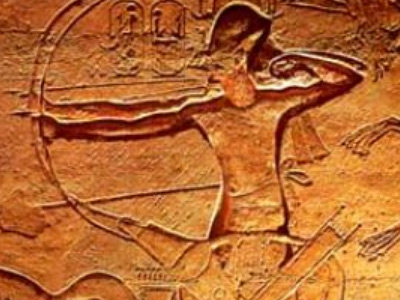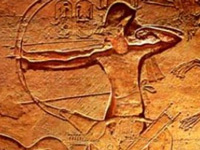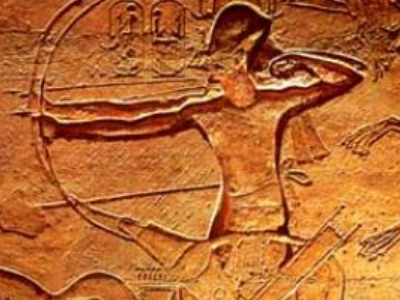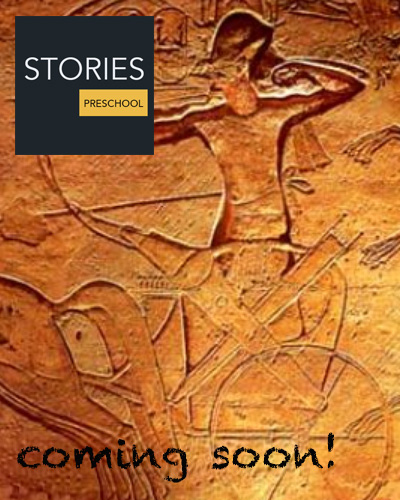Battle of Kadesh (1274 BC)

Kadesh Campaign
Ramesses' army crossed the Egyptian border in the spring of year five of his reign and, after a month's march, reached the area of Kadesh from the south.
The Hittite king Muwatalli, who had mustered several of his allies (among them Rimisharrinaa, the king of Aleppo), had positioned his troops behind "Old Kadesh", but Ramesses, misled by two spies whom the Egyptians had captured, thought the Hittite forces were still far off, at Aleppo, and ordered his forces to set up camp.
Contending forces
In the spring of the fifth year of his reign, in May 1274 BC, Ramesses II launched his campaign from his capital Pi-Ramesses (modern Qantir). The army moved beyond the fortress of Tjel and along the coast leading to Gaza. Ramesses led an army of four divisions: Amun, Re (P're), Seth (Suteh) and the apparently newly formed Ptah division.
There was also a poorly documented troop called the nrrn (Ne'arin or Nearin), possibly Canaanite military mercenaries with Egyptian allegiance or even Egyptians, that Ramesses II had left in Amurru, apparently in order to secure the port of Sumur. This division would come to play a critical role in the battle. Also significant was the presence of Sherden troops within the Egyptian army. This is the first time they appear as Egyptian mercenaries, and they would play an increasingly significant role in Late Bronze Age history, ultimately appearing among the Sea Peoples that ravaged the east Mediterranean at the end of the Bronze Age. Healy in Armies of the Pharaohs observes:
"It is not possible to be precise about the size of the Egyptian chariot force at Kadesh though it could not have numbered less than 2,000 vehicles spread though the corps of Amun, P'Re, Ptah and Sutekh, assuming that approx. 500 machines were allocated to each corps. To this we may need to add those of the Ne'arin, for if they were not native Egyptian troops their number may not have been formed from chariots detached from the army corps."
On the Hittite side, Ramesses II recorded a long list of nineteen Hittite allies brought to Kadesh by Muwatalli. This list is of considerable interest to Hittitologists, as it reflects the extent of Hittite influence at the time.
Battle
Ramesses II describes his arrival on the battlefield in the two principal inscriptions he wrote concerning the battle, the so-called "Poem" and the "Bulletin":
(From the "Poem") Now then, his majesty had prepared his infantry, his chariotry, and the Sherden of his majesty's capturing,...in the Year 5, 2nd month of the third season, day 9, his majesty passed the fortress of Sile. [and entered Canaan] ... His infantry went on the narrow passes as if on the highways of Egypt. Now after days had passed after this, then his majesty was in Ramses Meri-Amon, the town which is in the Valley of the Cedar.
His majesty proceeded northward. After his majesty reached the mountain range of Kadesh, then his majesty went forward...and he crossed the ford of the Orontes, with the first division of Amon (named) "He Gives Victory to User-maat-Re Setep-en-Re". His majesty reached the town of Kadesh ....The division of Amon was on the march behind him; the division of Re was crossing the ford in a district south of the town of Shabtuna at the distance of one iter from the place where his majesty was; the division of Ptah was on the south of the town of Arnaim; the division of Set was marching on the road. His majesty had formed the first ranks of battle of all the leaders of his army, while they were [still] on the shore in the land of Amurru.
(From the "Bulletin") "Year 5, 3rd month of the third season, day 9, under the majesty of (Ramesses II)...The lord proceeded northward, and his majesty arrived at a vicinity south of the town of Shabtuna.
As Ramesses and the Egyptian advance guard were about 11 kilometers from Kadesh, south of Shabtuna, he met two Shasu nomads who told him that the Hittite king was "in the land of Aleppo, on the north of Tunip" 200 kilometers away, where, the Shasu said, he was "(too much) afraid of Pharaoh, L.P.H., to come south." This was, state the Egyptian texts, a false report ordered by the Hittites "with the aim of preventing the army of His Majesty from drawing up to combat with the foe of Hatti." An Egyptian scout then arrived at the camp bringing two Hittite prisoners. The prisoners revealed that the entire Hittite army and the Hittite king were actually close at hand:
When they had been brought before Pharaoh, His Majesty asked, 'Who are you?' They replied 'We belong to the king of Hatti. He has sent us to spy on you.' Then His Majesty said to them, 'Where is he, the enemy from Hatti? I had heard that he was in the land of Aleppo.' They of Tunip replied to His Majesty, 'Lo, the king of Hatti has already arrived, together with the many countries who are supporting him... They are armed with their infantry and their chariots. They have their weapons of war at the ready. They are more numerous than the grains of sand on the beach. Behold, they stand equipped and ready for battle behind the old city of Kadesh.'
After this, Ramesses II called his princes to meet with him and discuss the fault of his governors and officials in not informing the position of Muwatalli II and his army. As Ramesses was alone with his bodyguard and the Amun division, the vizier was ordered to hasten the arrival of the Ptah and Seth divisions, with the Re division having almost arrived at the camp. While Ramesses was talking with the princes, the Hittite chariots crossed the river and charged the middle of the Re division as they were making their way toward Ramesses' position. The Re division was caught in the open and scattered in all directions. Some fled northward to the Amun camp, all the while being pursued by Hittite chariots.
The Hittite chariotry then rounded north and attacked the Egyptian camp, crashing through the Amun shield wall and creating panic among the Amun division. However, the momentum of the Hittite attack was already starting to wane, as the impending obstacles of such a large camp forced many Hittite charioteers to slow their attack; some were killed in chariot crashes. In the Egyptian account of the battle, Ramesses describes himself as being deserted and surrounded by enemies:
"...No officer was with me, no charioteer, no soldier of the army, no shield-bearer ..."
Only with help from the gods did Ramesses II defeat his attackers and return to the Egyptian lines:
"...I was before them like Set in his moment. I found the mass of chariots in whose midst I was, scattering them before my horses..."
The pharaoh, now facing a desperate fight for his life, summoned up his courage, called upon his god Amun, and fought valiantly to save himself. Ramesses personally led several charges into the Hittite ranks together with his personal guard, some of the chariots from his Amun division and survivors from the routed division of Re.
The Hittites, who believed their enemies to be totally routed, had stopped to plunder the Egyptian camp and, in doing so, became easy targets for Ramesses' counterattack. Ramesses' action was successful in driving the looters back towards the Orontes river and away from the Egyptian camp, while in the ensuing pursuit, the heavier Hittite chariots were easily overtaken and dispatched by the lighter, faster, Egyptian chariots.
Although he had suffered a significant reversal, Muwatalli still commanded a large force of reserve chariotry and infantry, plus the walls of the town. As the retreat reached the river, he ordered another thousand chariots to attack the Egyptians, the stiffening element consisting of the high nobles who surrounded the king. As the Hittite forces approached the Egyptian camp again, the Ne'arin troop contingent from Amurru suddenly arrived, this time surprising the Hittites. Finally, the Ptah division arrived from the south, threatening the Hittite rear.
After six charges, the Hittite forces were almost surrounded, and the survivors were pinned against the Orontes. The remaining Hittite elements not overtaken in the withdrawal were forced to abandon their chariots and attempt to swim across the river, according to Egyptian accounts hurriedly ("as fast as crocodiles swimming"), where many of them drowned.
There is no consensus about the outcome or what took place, with views ranging from an Egyptian victory to a draw, or, in the view of Iranian Egyptologist Mehdi Yarahmadi, an Egyptian defeat (with the Egyptian accounts simply propaganda). The Hittite army was ultimately forced to retreat, but the Egyptians were unsuccessful in capturing Kadesh.
HISTORY

RESOURCES
This article uses material from the Wikipedia article "Battle of Kadesh (1274 BC)", which is released under the Creative Commons Attribution-Share-Alike License 3.0.
© Stories Preschool. All Rights Reserved.









